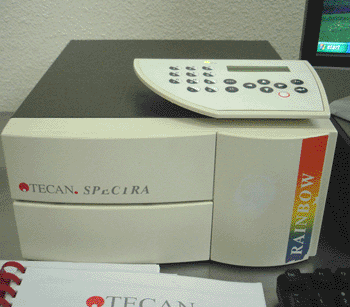Complement Fixation Endpoint Determined by Spectrophotometer
By LabMedica International staff writers
Posted on 18 Jun 2012
The complement fixation test is an immunological method that can be used to quantify the presence of either a specific antibody or a specific antigen in a patient's serum. Posted on 18 Jun 2012
The qualification of a positive antibody result is based on a subjective determination of 30% lysis of sheep red blood cells, which can lead to variability in the analysis as the endpoint is observed rather than measured in a machine.

Image
Scientists at the Associated Regional and University Pathologists Institute (ARUP; Salt Lake City, UT, USA) collected two sets of serum samples that had been sent for fungal complement fixation (CF) testing. Eleven samples sent for Coccidioides CF testing were used to assess laboratory technologist endpoint analysis precision and 60 samples sent for Coccidioides, Aspergillus, and Histoplasma mycelia CF testing were used to assess the utility of the spectrophotometric method.
Following the standard CF test, the clear supernatants were placed in round bottomed microplates alongside color standards ranging from 0% to 70% lysis in increments of 10% lysis. The plate was then analyzed by Tecan Rainbow F39200 spectrophotometer (Tecan Group Ltd.; Männedorf, Switzerland). A wavelength of 405 nm was chosen to read all samples as this is a standard wavelength available on common laboratory spectrophotometers and showed a significant optical density above background.
Of the 60 patient serum samples collected, 29 were positive and 31 were negative for CF antibodies against one of the fungal specific antigens by the non-spectrophotometric method. Of the patient serum samples with negative antibody titers, all 31 samples were verified to have negative titers by spectrophotometric analysis and did not vary from the original negative titer value. Of the 29 samples with positive CF antibody titers, 19 samples had titer endpoints that matched, and nine samples only varied endpoints by plus or minus one titer.
The authors concluded that utilizing the spectrophotometric method provided a standard reference by which 30% lysis could be accurately determined and reproduced. An inherent flaw with CF testing is the subjective nature in which the test is read that can lead to poor inter-technologist precision. If titer endpoint is inaccurately assessed, there is the potential for false positive or false negative results. The spectrophotometer method provides an objective means to obtain a titer endpoint, allowing for a reduction in errors caused by human endpoint assessment. The study was published on May 24, 2012, in the Journal of Clinical Laboratory Analysis.
Related Links:
ARUP Institute
Tecan Group Ltd.













